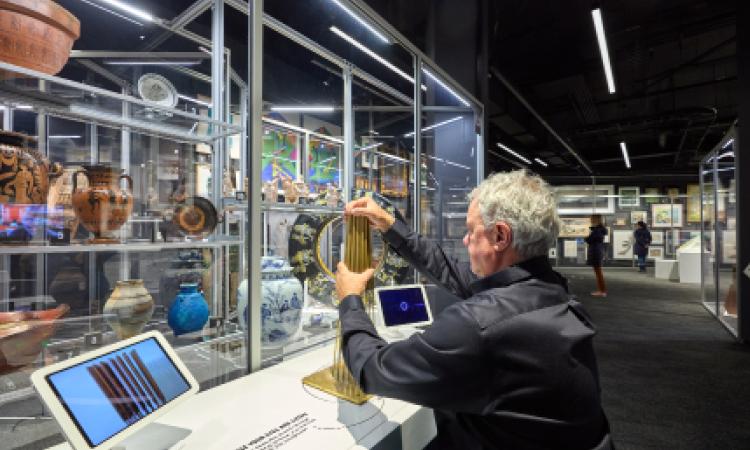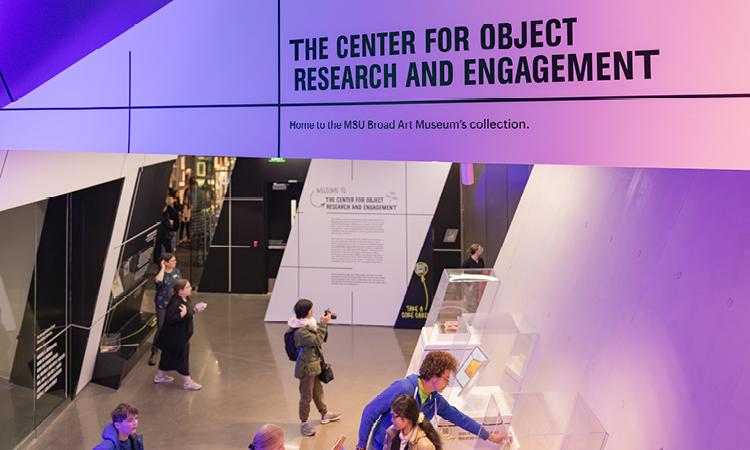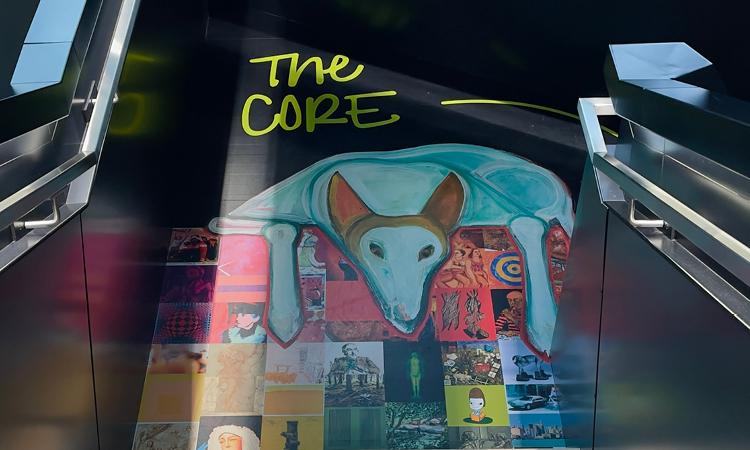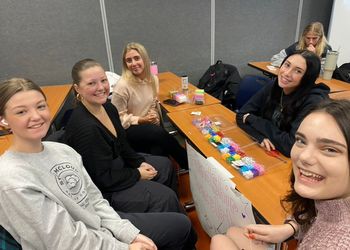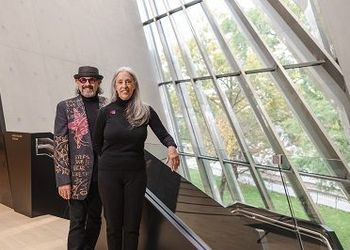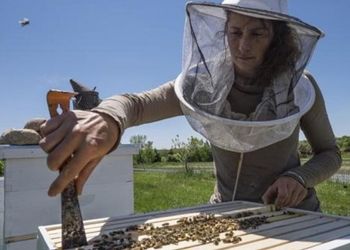Arts All Around Us
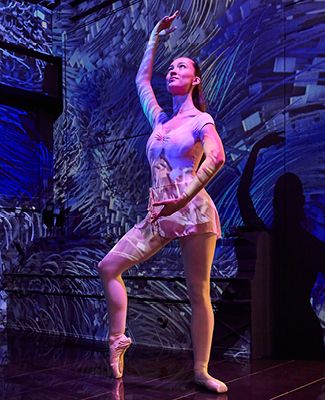
Arts All Around Us
February 26, 2024The arts have a unique way of opening doors. To ourselves, to each other and to big ideas. And Spartans, whose university was termed “an experiment” by its first president, especially recognize the value of creative, daring work.
Seeing the arts—collaborative, connective and generative at their core—as essential to a vibrant, inclusive and globally minded community advancing the common good, Michigan State University leadership launched Arts MSU last fall, an earnest and far-reaching effort that has been in the works since 2019. This unified approach seeks to integrate the arts across MSU—in classrooms, in research, in outreach, in campus infrastructure and more.
“This fall marked a tremendous step forward for our efforts to embed the arts across MSU’s missions, driving the kind of experimentation and innovation that are foundational to who we are as a university,” said Judith Stoddart, vice provost for university arts and collections. “Arts MSU makes visible the ways in which this strategy catalyzes discoveries and experiences at the intersection of disciplines, ideas and perspectives.”
By tapping into the arts’ longstanding record as a powerful and positive force in the world, Arts MSU aims to promote creativity and stimulate collaboration. It looks to heighten curiosity, accelerate discovery, propel knowledge sharing and foster richer perspectives of the world. It wants Spartans to feel more expressive and empowered, inspired and involved.
Here, Spartans share stories of incorporating the arts into their daily lives in spirited, fulfilling ways and shepherding artistic exploration and activities on and beyond the MSU campus.
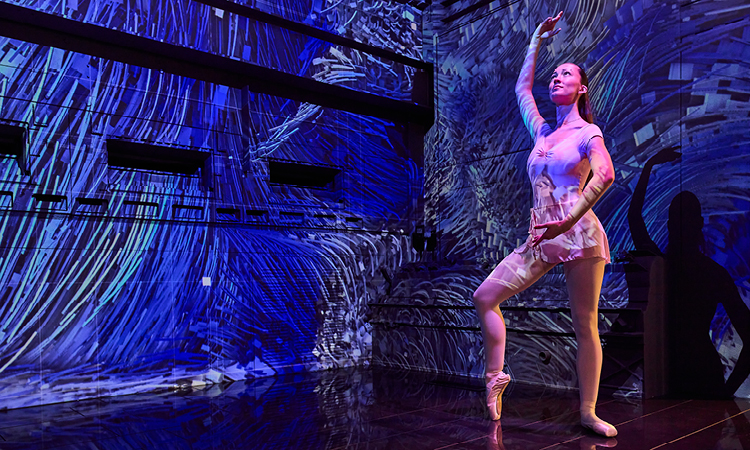
GRACE KRAJEWSKI “THE ARTS HELP MAKE ME MORE HUMAN”
A junior majoring in human biology, Grace Krajewski is also pursuing a minor in dance. It’s an admittedly unique academic balancing act connected to Krajewski’s past—she began toddler ballet classes in her hometown of Rochester Hills, Michigan, before embracing jazz, lyrical and other forms as a youth—and her future ambitions, namely medical school.
While the two disciplines excite her in different ways, each serving different personal objectives for Krajewski, she never expected them to intersect during her time at MSU. But they have—and in dynamic ways stimulating Krajewski’s mind, breeding unlikely relationships and deepening her sense of Spartan pride.
Krajewski recalls sitting in a physiology class one day learning about the organized composition of the human body. Later that same day, she listened to her contemporary dance teacher explain how the body moves in coordination.

“Lightbulbs started going off for me,” Krajewski said. “These fields that seemed so disparate, so distinct, suddenly became related, which was amazing to understand. It began to change everything for me.”
But it was only the first step in a more mind-opening, soul-enriching journey.
In October 2022, Krajewski joined a motion capture research project led by Brad Willcuts, associate professor of musical theater, choreography and dance at MSU’s College of Arts & Letters. Given her dance background, Krajewski was tabbed to don a motion capture suit and perform a series of movements. While the motion capture work informed Willcuts’ 3D body mapping project, it also provided Krajewski a deeper understanding of the body’s interconnectedness—how muscles, joints and limbs move independently, in unison and because of one another.
Krajewski said the ability to study the human body and dance in parallel has allowed her to exercise both sides of her brain, awakened a richer understanding of the body and enlivened her experience at MSU. Above all, though, it’s helped her become a more well-rounded, approachable individual who recognizes the importance of cultivating relationships and introspection as a routine habit.
“I have no question the arts help make me more human, which is why I’m so grateful I have them in my life,” Krajewski said.
RUTH NICOLE BROWN “THE ARTS ARE A BRIDGE ENABLING US TO SPEAK TO ONE ANOTHER BEYOND OUR EXPERTISE”
Ask Ruth Nicole Brown about Arts MSU and she offers an enthusiastic reply.
The chair of the Department of African American and African Studies (AAAS) housed within MSU’s College of Arts & Letters, Brown appreciates the universitywide initiative and, specifically, its commitment to bringing the arts into more direct contact with the social sciences and STEM fields.
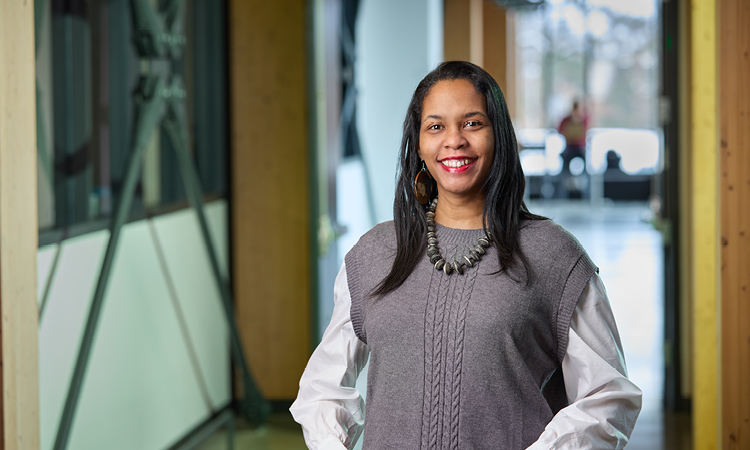
“The deepest thinker in physics often has a lot in common with the deepest thinker in AAAS, and the arts are often a bridge enabling us to speak to one another beyond our technical expertise,” Brown said.
The arts feature prominently in AAAS’s curriculum. Faculty regularly task students to leverage artistic practices like performance, poetry, painting, mixed media design and dance, while an assignment like sonic introductions challenges students to introduce themselves to classmates by integrating sound and music.
Meanwhile, AAAS faculty are artist-scholars themselves, including Brown, who engages in theatre, poetry and music. Their artistic creativity and intellectual curiosities are integrated, foundational to how they lead and transgressive.
“The arts are present in how we interact with one another, and we not only plan to continue advancing and amplifying the arts and humanities, but we also aspire to combine our creative forces as one way to showcase the irresistibility of the chorus,” Brown said.
To that end, Brown is working to build artistic spaces within her department. This spring, AAAS will debut a recording studio to jump-start creative expression and collaborative ventures among AAAS faculty, students and staff as well as music makers across MSU and the greater Lansing community.
“The studio will be a place to build community, create culture, play together, share information and advance knowledge, all things the arts and humanities do so beautifully well,” Brown said.
Brown calls the arts a necessary component of “an excellent 21st century education” and a valuable avenue to address problems and nourish ideas. As many students come to MSU curious and eager to make a difference in the world, Brown said active involvement with the arts can feed both objectives.
“We’re living in a time in which people are leaning on the arts and humanities to express themselves, to dream new worlds and say some things differently,” Brown said. “We’re wise to support them in their journeys.”
STEVEN BRIDGES “ARTS ARE CRITICAL TO DEVELOPING THE WHOLE PERSON”
The Eli and Edythe Broad Art Museum at Michigan State University (MSU Broad Art Museum) emphasizes object-based learning, an educational approach that encourages close examination of artworks, using them as a tool to think critically about the world.
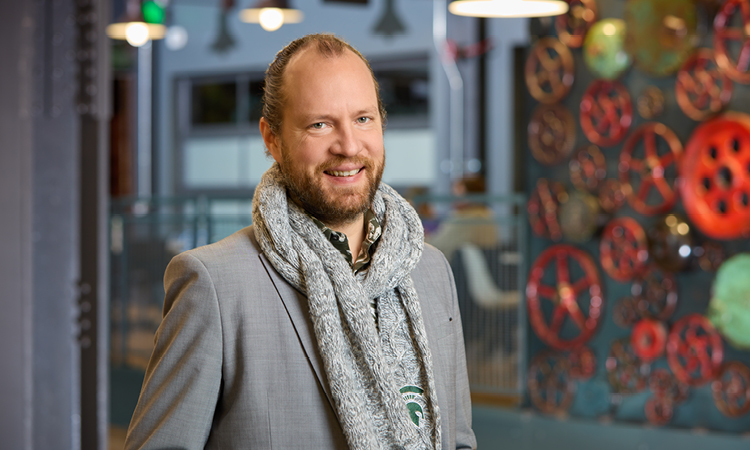
According to Steven Bridges, the museum’s interim director, senior curator and director of curatorial affairs, that educational emphasis is intentional, grounded in the belief that direct engagement with the museum’s objects—over 10,000 works spanning histories, geographies and cultures—fosters meaningful dialogue, an openness to diverse viewpoints and a greater understanding of the world.
“Ultimately, art is about breaking down silos and synthesizing information, which sits at the heart of learning, teaching and education,” Bridges said.
That philosophy, in fact, has pushed the MSU Broad Art Museum to partner on innovative programs like Global DEI Through Art. Using the museum’s collection as a gateway to cultural discovery, the annual teacher fellowship program equips Michigan-based K-12 educators with skills and strategies to broaden students’ understandings of global diversity, equity and inclusion in the classroom.
The museum’s newly opened Center for Object Research and Engagement (The CORE), however, might be the greatest testament to this educational approach.
Filling more than 4,500 square feet of renovated space on the museum’s lower level, The CORE places nearly 300 works of art from the museum’s permanent collection on view, elevating access and visibility of a collection covering 5,000 years of art history. With purpose and enthusiasm, The CORE highlights diverse stories, values and worldviews. It stimulates curiosity. It uplifts scholarship and motivates fresh perspectives. And it exemplifies the spirit and mission of Arts MSU—driving experiences with the arts truly unique to the Michigan State campus.
“Arts are critical to developing the whole person as a global citizen,” Bridges said. “In putting the arts at the center of what we’re doing on campus, we’re unlocking opportunities for the type of growth and discovery central to our mission at MSU and the MSU Broad Art Museum.”
FAITH NHKUM “ART ENCOURAGES EXPLORATION”
As a child, Faith Nhkum was fascinated by the arts, specifically animation. Every opportunity to exercise her creativity and imagination delivered energy and joy.
In high school, however, a love for science emerged. Upon arriving at MSU as a microbiology major, the California native assumed she’d be forced to surrender any artistic pursuits to the demands of science.
“I thought it was game over,” Nhkum said.
But Nhkum refused to abandon her artistic passions. She tossed an art class onto her first-semester class schedule, added a minor in comic art and storytelling at the close of her freshman year and began attending MSU Painting Club events where she encountered other artistic souls from across the MSU community students majoring in fields like mathematics and neuroscience, physics and dietetics.
For Nhkum, a junior recently elected president of the MSU Painting Club, the arts provide an intellectual and spiritual equilibrium and access to a richer, more satisfying undergraduate life.

“After a long day of being given scientific facts and direct instructions, the arts permit my mind to wander while my heart does much of the work,” Nhkum said.
Unexpectedly, the arts are informing her microbiology studies as well, fostering creativity and problem-solving in her science, such as the type of media she will use to develop cultures.
“Art encourages exploration and I see how important that is to science when it comes to thinking about creative ways to better an experiment or developing a different approach,” she said.
Nhkum’s artistic pursuits have also empowered her to generate awareness around social issues she cares about. In October, she was one of 13 MSU students awarded a CREATE! Micro-Grant, a College of Arts & Letters-spearheaded program encouraging students to use the arts as a vehicle to critically examine current events. Nhkum’s charcoal drawing, soon to be displayed in the program’s online exhibit, highlights the genocide of the Jinghpaw people in Myanmar, her parents’ homeland.
“If I just lived in my microbiology world, I’d never have the opportunity to speak about what’s happening in Myanmar,” Nhkum said. “But art gives me a voice, which is so amazing to me and, hopefully, impactful to others.”
SANDRA SNOW “ARTS ARE THE ULTIMATE WAY OF LOOKING AT THE WORLD”
The director of choral programs at the MSU College of Music, Sandra Snow sees an opportunity for music—already a popular artistic medium to comfort, entertain and unite—to be an even greater asset to MSU and society at large.
For Snow, Arts MSU is license to think with heightened ambition and intent about injecting music deeper into the campus environment as well as external communities to ignite relationships and invigorate lives.
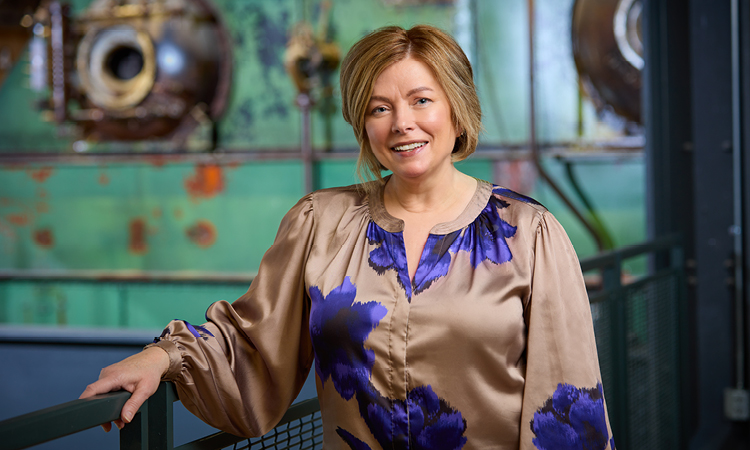
The College of Music already hosts a range of choirs for music and non-music majors alike. The Choral Union, for instance, is a “town and gown” group composed of faculty, staff, retired people and members of the greater East Lansing community ranging in ages from 18 to 80. It’s a glittering example of music’s ability to connect people from distinct backgrounds and spawn positive energy.
Bolstered by Arts MSU, Snow is now actively exploring ways to broaden music’s reach. Perhaps moving choral programs outside of the College of Music’s headquarters on West Circle Drive. Maybe offering additional participatory musical experiences that do not require involved, formal training.
“Singing is for everyone, and the benefits aren’t necessarily tied to study exclusively,” she said.
Snow also aims to expand the concept of musical scholarship, including efforts extending beyond the MSU campus. She sees opportunity for outreach-focused final projects, such as bringing music into a hospice facility or organizing prison choirs.
“There’s so much potential meaning and value we can extract here,” she said.
Such promise excites Snow, compelling her to push boundaries and imagine new realities rooted in music and its power to feel, heal and connect.
“Arts are the ultimate way of looking at the world beyond our own lived experiences and it promotes a more empathetic way of being in the world,” she said. “Engaging in and with the arts is a powerful means of self-expression that makes us feel present and in the moment. If we can make the arts more accessible, inclusive and alive to more people, we certainly should.”
GROOVE DOCTORS “MUSIC IMITATES LIFE”
Their Instagram bio (@groovedoctors3) says it all: “Not quitting their teaching gigs at the local U, but still swingin’ with some of the sweetest R&B/Jazz/Rock around.”
They’re the Groove Doctors: Michael Lawrence (Professor of Law, Guitar/Vocals), David Stowe (Professor of Religious Studies, Drums) and Glenn Chambers (Professor of History, Interim Dean Residential College in the Arts and Humanities, Bass). The lifelong musicians and longtime friends meet up after class to let loose with their eclectic spin on hits and deep cuts from artists like Prince, Al Green and Stevie Wonder, plus a repertoire of originals they’re recording into an album.

The professors—who play live shows at mid-Michigan breweries, bars, farmers’ markets, festivals and weddings—have found music helpful in honing many life skills: focus, reaction, performance and self-expression. It requires a combination of creativity and discipline that helps people flourish both professionally and personally.
“Music, when you’re performing, totally absorbs your attention,” said Stowe. “There’s a real benefit to that kind of mindfulness.”
And while carrying a tune may not be a prerequisite for most degrees, Lawrence knows the power of music is very present in the classroom and beyond. “Focus, discipline, organization. It’s all required to succeed in law school, and then as a lawyer,” he said.
“Music imitates life in a lot of ways,” added Chambers, leading into a lesson that straddles the line between music and life. “Sometimes you need to fill the space and sometimes it’s better to be silent. You’ve just got to feel the vibe.”
Contributing Writer(s): Daniel P. Smith


